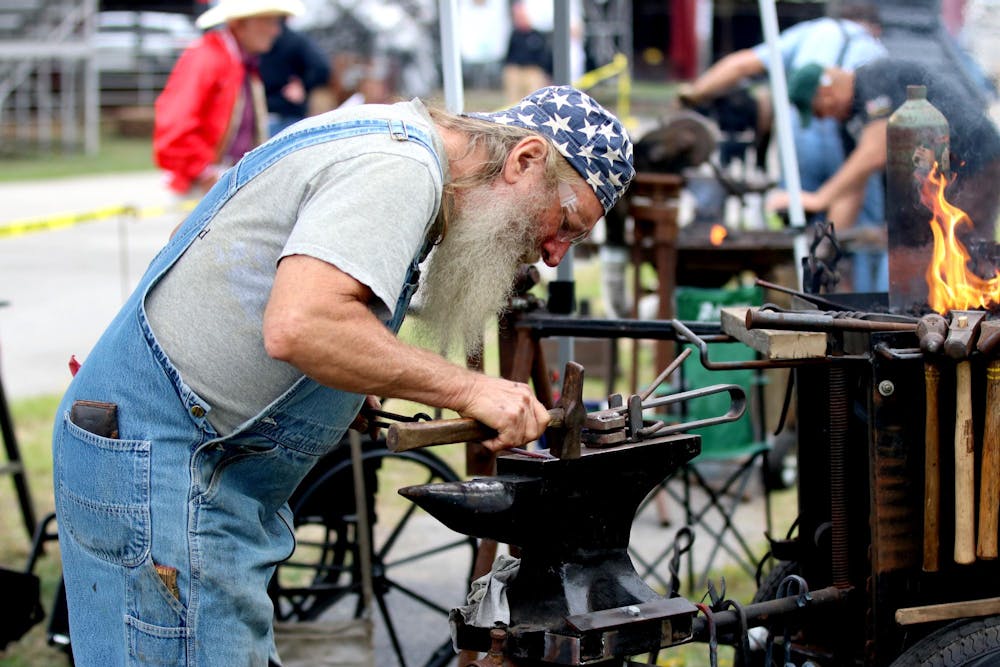When the word “blacksmith” is mentioned in 2025, a few things may come to mind. Medieval history books, movies and reality TV, weapons and maybe older men with long, scruffy hair. However, South Carolina’s small but strong community of passionate metal workers go far beyond any stereotypes.
Many of the state’s blacksmiths hold membership in the 190-strong Philip Simmons Artist Blacksmith Guild. The nonprofit organization was founded in 1994 and renamed in 1998 to honor Simmons, an accomplished Charleston blacksmith and artist who devoted much of his later life to mentoring aspiring blacksmiths.
The guild is the only of its kind in South Carolina, bringing together young and old blacksmiths to work together and learn from each other. Anyone is free to join regardless of experience, with annual dues of $20.
The guild hosts six annual meetings, located at various locations throughout the state, where new and old members can learn from each other. The guild also hosts blacksmithing demonstrations at places such as the state fair and local art studios.Members work on a wide variety of projects, including ornamental gates, Damascus blades and cabinets.
Ray Pearre is a75-year-old who joined the guild 18 years ago. He serves as secretary treasurer, managing the organization’s budget. Pearre said blacksmithing is anything but a lost art and that mentorship is one of the group’s core values.
“That would be the primary way that I have learned,” Pearre said. “With the availability of experienced blacksmiths, we become a resource.”
Pearre, a mechanical engineer, always wanted to explore blacksmithing, and a class he took in 2007 finally gave him the chance to pursue it.
“Ever since then, I’ve been hooked,” Pearre said.
Robert Stukes, a 77-year-old retired teacher who also joined in 2007 and serves as a board member. Stukes saud the guild’s main goal is to preserve the rich history and culture around blacksmithing.
Stukes also said the guild brings together a highly diverse set of people.
“I’ll tell you what’s great about it: the people,” Stukes said. “They come from different classes, different cultures (and) different educational levels.”
Pearre said the personal connections he’s crafted are just as important as the products. Stukes, who called Pearre his best friend, said teaching the art is the key to fueling its future.
“We need young people if it’s going to survive because it’s an art that still can be used, even if it’s just artistic,” Stukes said. “You can create any kind of thing you can imagine.”
Thomas Bosse, a fellow member of the guild and instructor of USC’s School of Visual Art and Design, said he’s working to make that happen. For Bosse, metalwork is a powerful personal outlet nothing else can match.
“The moment I swung that hammer and started moving metal, something just clicked,” Bosse said. “It just makes sense.”

Metal displays at the Blacksmith Exhibition at the South Carolina State Fair on Oct. 10, 2025. These items were made by members of the Philip Simmons Blacksmith Guild.
In addition to being a blacksmith, Bosse is an experienced educator, having taught classes from kindergarten to graduate school. His work has been featured in the New York Jewelry Week and Schmuck Jewelry Week in Europe.
He said teaching evokes a similar feeling to metalwork itself.
“It’s always exciting to see that spark, and it almost always comes from our students who don’t expect it,” Bosse said. “You can see it in their eye. There’s just something that excites them when they’re working.”
One of Bosse’s former students, Jenna Armstrong, a May 2025 USC studio art alumna, didn’t come into college with an interest in blacksmithing, but rather graphic design.
Armstrong said she’d always loved all kinds of art, but, once she discovered blacksmithing, the tactile experience of physical design was addicting.
“I love to be able to walk around it and see it, touch it (and) fully be immersed in it,” Armstrong said. “I started taking more and more sculpture classes, and eventually, we started working with metal.”
In addition to his personal mentorship, Armstrong said Bosse was also valuable in helping her identify female role models in a field that’s often male-dominated. Post-graduation, Armstrong has been saving for equipment and meeting with local blacksmiths and artists to help in advancing her own goals.
The potential to combine creativity and functionality is what Armstrong said draws her to blacksmithing.
“What excited me was being able to play around with it,” Armstrong said. “To highlight that contrast. Super hard, sturdy materials can create softer forms. And again, you can essentially make it into anything you want.”
Bosse said his growing passion for blacksmithing had a strong effect on both student and teacher.
“I know what it means to come from a family who might not understand art quite as much as some other people,” Bosse said. “Being able to make functional work that your family can relate to, you could tell it was particularly meaningful for her too.”
Though Armstrong hasn’t attended any guild events yet, she said she’d be excited to if one came to her area. She said that blacksmiths, regardless of initial appearances, tend to be highly welcoming.
“The same can be said about them as a material, it could on the outside be looking rough, covered in grit and grime,” Armstrong said. “The community is very nice and open to people viewing and people's interests. For me, it’s definitely helped not only get my name out there, but also just experiencing different people’s perspectives.
Stukes said that whether blacksmiths are hobbyists like himself or masters that make a living off their creations, artistry is always there.
“Some of these people made a living by just working with metal and making,” Stukes said. “Those people are artists.”
More information on the Philip Simmons Artist Blacksmith Guild can be found here. The Guild’s next regular meeting will be held Oct. 18 at Lexington County Museum.

